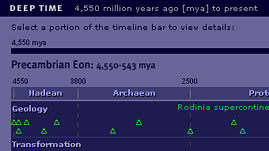Teachers' Domain - Digital Media for the Classroom and Professional Development
User: Preview


Source: Evolution Web site
Earth has been significantly altered over its 4.6-billion-year history by climate swings, vulcanism, drifting continents, and more. These dynamic conditions, in turn, have influenced every living thing that has inhabited the planet. This interactive timeline from the Evolution Web site provides a framework through which to learn about geological events that have shaped the planet and its past and present life forms, and to better appreciate the timescale over which numerous remarkable transformations have occurred.
Since taking hold on Earth more than 3.8 billion years ago, life has never let go. Evolutionary transformations along the way -- changes in the forms and functions of living things -- have yielded tremendous diversity. As much as evolution is about life and its many forms, however, Darwin's theory involves more than can be explained by biology alone. To fully understand the conditions in which life has evolved, we must integrate other sciences, including geology, chemistry, and physics, into our study of life on Earth.
The physical environment determines how much of the fossil record is preserved for scientific analysis. Based on the work of taphonomists, scientists who study how organic remains are preserved, we know that a rare set of circumstances must combine to produce fossils. For instance, the body of a Paleozoic reptile had to have fallen on the muddy soil of a streambed when it died. That streambed would, in turn, have to have been quickly covered by other sediment layers that protected the remains from oxidation and microbes, and then it had to have been left undisturbed as long as it took for minerals in the ground to replace those in the bones.
Because Earth is such a dynamic planet, hundreds of millions of species may already have become extinct. Knowledge of these species is likely to elude scientific discovery even if the organisms did happen to leave fossils behind. With Earth's crust in constant motion, as new material surfaces through volcanoes and undersea ridges, older material is consumed through earthquakes, weathering, and other natural processes. When Earth's rocks and features are destroyed, evidence of past life that might otherwise help scientists in their construction of a "tree of life" is also destroyed. The fossil record, like a puzzle with missing pieces, will always contain gaps.
To learn about how paleontologists use fossils to reconstruct an organism's appearance, check out Fossils: An Ancient Sea in Indiana.
To view images of fossils from different geologic time periods, check out Fossils.
To learn more about how to find the ages of rock, check out Radiometric Dating.
To learn more about radiocarbon dating, check out The Dating Game: Radioactive Carbon.
To learn more about geologic time, check out The Wall of Time.
 Loading Standards
Loading Standards Teachers' Domain is proud to be a Pathways portal to the National Science Digital Library.
Teachers' Domain is proud to be a Pathways portal to the National Science Digital Library.
